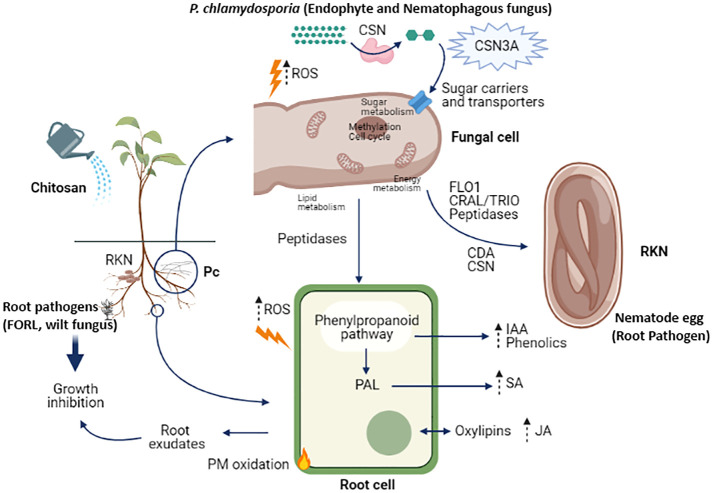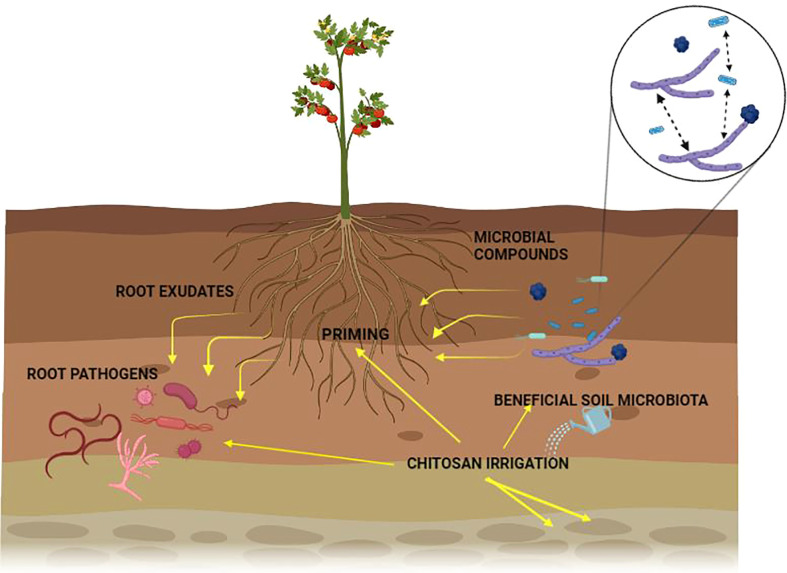Chitosan and nematophagous fungi for sustainable management of nematode pests.
IF 2.1
Q3 MYCOLOGY
Frontiers in fungal biology
Pub Date : 2022-10-24
eCollection Date: 2022-01-01
DOI:10.3389/ffunb.2022.980341
引用次数: 1
Abstract
Plants are exposed to large number of threats caused by herbivores and pathogens which cause important losses on crops. Plant pathogens such as nematodes can cause severe damage and losses in food security crops worldwide. Chemical pesticides were extendedly used for nematode management. However, due to their adverse effects on human health and the environment, they are now facing strong limitations by regulatory organisations such as EFSA (European Food Safety Authority). Therefore, there is an urgent need for alternative and efficient control measures, such as biological control agents or bio-based plant protection compounds. In this scenario, chitosan, a non-toxic polymer obtained from seafood waste mainly, is becoming increasingly important. Chitosan is the N-deacetylated form of chitin. Chitosan is effective in the control of plant pests and diseases. It also induces plants defence mechanisms. Chitosan is also compatible with some biocontrol microorganisms mainly entomopathogenic and nematophagous fungi. Some of them are antagonists of nematode pests of plants and animals. The nematophagous biocontrol fungus Pochonia chlamydosporia has been widely studied for sustainable management of nematodes affecting economically important crops and for its capability to grow with chitosan as only nutrient source. This fungus infects nematode eggs using hyphal tips and appressoria. Pochonia chlamydosporia also colonizes plant roots endophytically, stimulating plant defences by induction of salicylic and jasmonic acid biosynthesis and favours plant growth and development. Therefore, the combined use of chitosan and nematophagous fungi could be a novel strategy for the biological control of nematodes and other root pathogens of food security crops.



壳聚糖和食线虫真菌用于线虫害虫的可持续管理。
植物面临着由食草动物和病原体引起的大量威胁,这些威胁对作物造成了重大损失。线虫等植物病原体会对全球粮食安全作物造成严重破坏和损失。化学杀虫剂被广泛用于线虫防治。然而,由于它们对人类健康和环境的不利影响,它们现在面临着欧洲食品安全局等监管组织的严格限制。因此,迫切需要替代和有效的控制措施,如生物控制剂或生物基植物保护化合物。在这种情况下,壳聚糖,一种主要从海鲜废料中获得的无毒聚合物,变得越来越重要。壳聚糖是甲壳素的N-脱乙酰基形式。壳聚糖对防治植物病虫害是有效的。它还诱导植物防御机制。壳聚糖还与一些生物防治微生物(主要是昆虫病原菌和食线虫真菌)相容。它们中的一些是植物和动物线虫害虫的拮抗剂。嗜线虫生物防治真菌厚壁孢Pochonia chlamydosporia已被广泛研究,以可持续管理影响经济重要作物的线虫,并使其能够以壳聚糖为唯一营养源生长。这种真菌利用菌丝顶端和附着胞感染线虫卵。厚垣孢子虫也内生定殖植物根系,通过诱导水杨酸和茉莉酸的生物合成刺激植物防御,有利于植物生长发育。因此,壳聚糖和食线虫真菌的联合应用可能是一种新的生物防治粮食安全作物线虫和其他根源病原体的策略。
本文章由计算机程序翻译,如有差异,请以英文原文为准。
求助全文
约1分钟内获得全文
求助全文

 求助内容:
求助内容: 应助结果提醒方式:
应助结果提醒方式:


